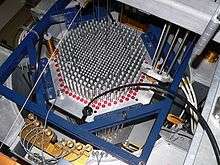CROCUS
Coordinates: 46°31′16″N 6°34′13″E / 46.521238°N 6.570361°E


CROCUS is a research reactor at École polytechnique fédérale de Lausanne in Switzerland, sometimes described as zero power but in fact limited to 100 W.
This low power means that within a few hours of shutdown, it is safe for personnel to enter the biological shield, as the residual radioactivity of the core has decayed to safe levels. The biological shield consists of a concrete wall, with a 14-ton door for personnel access. There is also a removable 50-ton concrete trapdoor in the top of the shield, to allow for fuel and equipment changes.
CROCUS uses low-enriched uranium (LEU) metal fuel, immersed in a tank of demineralised light water which acts as moderator and reflector. There is no special provision for cooling required.
CROCUS is controlled by two control rods and by adjusting the water level in the moderator tank. A neutron source is placed under the core to aid startup. In addition, there are two safety control rods and four surge tanks, making six independent safety systems. Any one of these six is capable of producing a complete emergency shutdown (scram) in less than one second, and is triggered automatically should power exceed the authorised level.
CROCUS is used for teaching reactor physics.
Notes and references
External links
| Wikimedia Commons has media related to Crocus installations at the EPFL. |
- CROCUS page at the École Polytechnique Fédérale de Lausanne website.